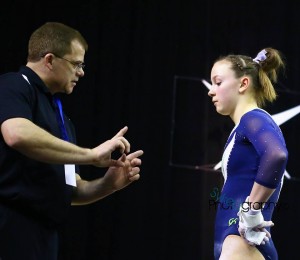I just finished a pretty busy spring where I have been coaching at The International Challenge part of Gym Nix International. A Training Camp in Whitehorse in the Yukon, The University of Calgary International Cup and most recently in Iceland.
At Gymnix there were teams from Canada, US, Sweden, France, Belgium, and Wales.
Some pretty fantastic gymnastics. What was apparent with these gyms was that they a program and a system to become successful. Whether it was Liukin and WOGA or the Team from Manitoba. They had a plan and a system. They nurtured the gymnasts, taught them gymnastics, taught them how to compete. They new where they were and they knew where they were going.
 One of the clubs I consult with KIDSPORT from Minnesota was there. It was their gymnast (Lexy) first International competition. Rob knew what Lexy’s basic bar routine was going to be years ago. There were adjustments (A Comenecci as opposed to a Gienger. A full out as opposed to double lay out) but he had a plan. Watching his videos of 5 kids in a row NAIL triple fulls, and 3 kids in a row do a full in or full out, he obviously has a plan and knows not only what he wants from the group but he also makes wise skill selection for the individuals.
One of the clubs I consult with KIDSPORT from Minnesota was there. It was their gymnast (Lexy) first International competition. Rob knew what Lexy’s basic bar routine was going to be years ago. There were adjustments (A Comenecci as opposed to a Gienger. A full out as opposed to double lay out) but he had a plan. Watching his videos of 5 kids in a row NAIL triple fulls, and 3 kids in a row do a full in or full out, he obviously has a plan and knows not only what he wants from the group but he also makes wise skill selection for the individuals.
Any one can get lucky with a talented kid walking into their gym. BUT- what are you going to do with it? How many kids in a population show above average talent? 1 in 10? 1 in 20? 1 in 100?
How many kids show that SPECIAL thing to bring them to the top? 1 in 1000? 1 in 10,000?
You need to make your gym a magnet for talent. The only way to do that is to:
- take the mediocre kid and make them AVERAGE
- The average kid and make them GOOD
- The good kid and make them GREAT
- And the Great kid and make the AMAZING.
Talk is Cheap
It is so easy to talk about excellence, winning, commitment and leadership but what actions are you actually taking to achieve those things? What is your specific action plan? Who is going to help and guide you? What changes do you need to make to be the best you can be? What are you willing to sacrifice? Stop talking about it and do something now.
The path to EXCELLENCE is paved with good intentions – turn the intentions into action!
Characteristics of a Sound Training Program
In all my travels I have been getting requests to evaluate their training programs. Rather than specifically evaluate any program I think it is better to describe the characteristics of a sound program and you can use this to evaluate and draw your own conclusions.
Technique- You can not argue with physics and mechanics. Our bodies and the equipment react to certain constants and constraints. As I have said before- the technique you teach needs to become your religion.
Progression – You should be able to see clear definitive progression both inter and intra workout. In addition the progression should take into account training age.
Clearly Defined Goals – A sound program starts with the end in mind and clearly works toward that end.
Training is a means to an end – Training should not be an end unto itself.
Individual – A sound training program fits the individual and takes into account trainability and recoverability. Not Every drill is going to work with every gymnast. Not every skill is appropriate for every gymnast.
Beyond the Exercise – It is always more than an exercise or a drill. The drill or exercise is a means to an end.
Can Do – A sound program will focus on what the athlete can do, not what they can’t do. Optimize the strengths and minimize the weaknesses.
Risk – Manage risk by weighing the risk:return ratio of the training methods.
Variation – Incorporate programmed systematic variations to insure continual adaptation.
Spectrum – Incorporate a spectrum of methods that insure all systems are trained all the time.
Basics – Never stray far from the basics, no gimmicks, no fads and no quick fixes.




